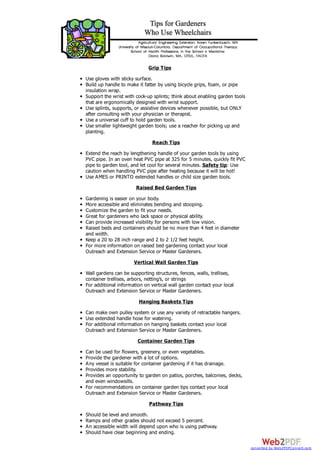Tips for gardeners that use wheelchairs
- 1. Grip Tips Use gloves with sticky surface. Build up handle to make it fatter by using bicycle grips, foam, or pipe insulation wrap. Support the wrist with cock-up splints; think about enabling garden tools that are ergonomically designed with wrist support. Use splints, supports, or assistive devices whenever possible, but ONLY after consulting with your physician or therapist. Use a universal cuff to hold garden tools. Use smaller lightweight garden tools; use a reacher for picking up and planting. Reach Tips Extend the reach by lengthening handle of your garden tools by using PVC pipe. In an oven heat PVC pipe at 325 for 5 minutes, quickly fit PVC pipe to garden tool, and let cool for several minutes. Safety tip: Use caution when handling PVC pipe after heating because it will be hot! Use AMES or PRINTO extended handles or child size garden tools. Raised Bed Garden Tips Gardening is easier on your body. More accessible and eliminates bending and stooping. Customize the garden to fit your needs. Great for gardeners who lack space or physical ability. Can provide increased visibility for persons with low vision. Raised beds and containers should be no more than 4 feet in diameter and width. Keep a 20 to 28 inch range and 2 to 2 1/2 feet height. For more information on raised bed gardening contact your local Outreach and Extension Service or Master Gardeners. Vertical Wall Garden Tips Wall gardens can be supporting structures, fences, walls, trellises, container trellises, arbors, nettingŌĆÖs, or strings For additional information on vertical wall garden contact your local Outreach and Extension Service or Master Gardeners. Hanging Baskets Tips Can make own pulley system or use any variety of retractable hangers. Use extended handle hose for watering. For additional information on hanging baskets contact your local Outreach and Extension Service or Master Gardeners. Container Garden Tips Can be used for flowers, greenery, or even vegetables. Provide the gardener with a lot of options. Any vessel is suitable for container gardening if it has drainage. Provides more stability. Provides an opportunity to garden on patios, porches, balconies, decks, and even windowsills. For recommendations on container garden tips contact your local Outreach and Extension Service or Master Gardeners. Pathway Tips Should be level and smooth. Ramps and other grades should not exceed 5 percent. An accessible width will depend upon who is using pathway. Should have clear beginning and ending. converted by Web2PDFConvert.com
- 2. Textured surface for traction and orientation and contrasting colors and textures. Turf is cheap and cool but requires maintenance. Being soft is not user friendly to wheelchairs. Also, turf will die in high traffic areas. One solution, mix it with concrete blocks or paving stones. Wood chips, grass, mulch, compacted soil, crushed limestone, and gravel are too soft and need replacement. BUT, will cushion falls. Hard paving surfaces meet pathway requirements, but will not cushion falls and can be expensive. Can use concrete, asphalt, power block, patio block (stepping stones) brick, flagstone, or wood. Gardening from a Wheelchair Websites Accessible Gardening Websites Planning an Accessible Garden Susan's Gardenlinks Page Gardening from a Enabled Gardeners Links Wheelchair Garden Forever Accessible Patio Gardening Chicago Botanic Garden Square Foot Gardening: Wheelchair Gardening HandHelpers.com For a list of books and booklets about Gardening from a Wheelchair, please click here. For additional information contact your local University of Missouri Extension Center or the University of Missouri AgrAbility Project, at 1.800.995.8503. Legal Partnership, and Contact Information This material is based upon work supported by the Cooperative State Research, Education, and Extension Service (CSREES), U. S. Department of Agriculture under special project number 2001-41590-01143 and the U.S. Department of EducationŌĆÖs National Institute on Disability and Rehabilitation Research under special project number H133B980022. Equal opportunity is and shall be provided to all participants in Extension programs and activities, and for all employees and applicants for employment on the basis of their demonstrated ability and competence without discrimination on the basis of their race, color, religion, sex, sexual orientation, national origin, age, disability, or status as a Vietnam-era veteran. This policy shall not be interpreted in such a manner as to violate the legal rights of religious organizations or military organizations associated with the armed forces of the United States of America. converted by Web2PDFConvert.com


